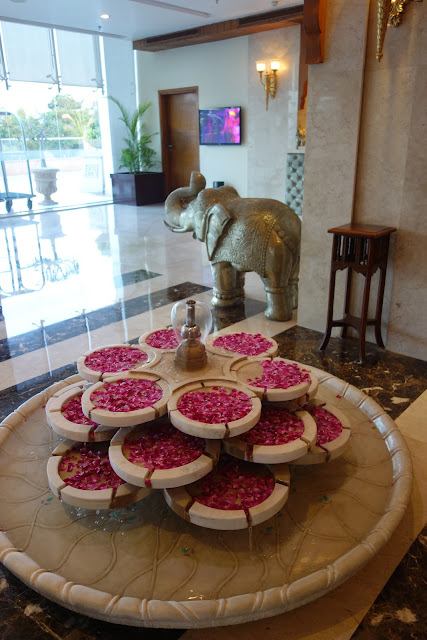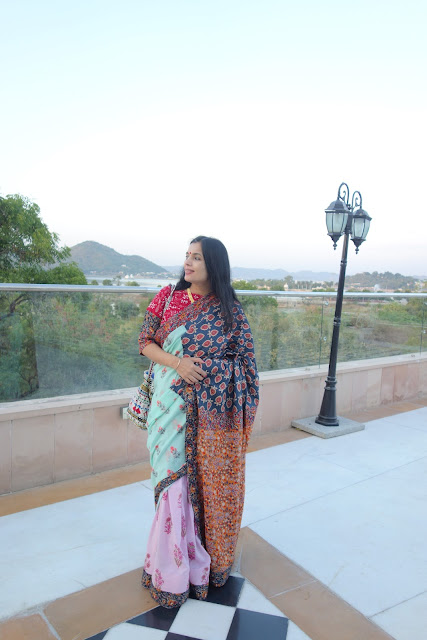This post shows you some nice client pictures wearing Kani sarees from Sohum Sutras, which are selling like hotcakes in this season. These sarees can be worn all year round- summers and winters, as they are made of cotton silk. You can see many colour options of Kani sarees.
Everyone knows about Kani shawls. They are hand woven shawls made in Kashmir. For the first time in India, sold exclusively through our label, "Sohum Sutras", we have developed Kani sarees. These are cotton silk sarees with jacquard made with Kani weave. With the wedding season coming up, these sarees will look extremely trendy in any function. They spell elegance and richness. They are subtle, understated and yet make a statement.
They are not available anywhere else in India. To order and for enquiries, please email
kiran.sawhney@gmail.com
Kani is an item of luxury consumption since the sixteenth century. Kani weave holds a special value and there are few master craftsmen today capable of this delicate work. Like an impressionist painting, Kani weave is a beautiful recreation of nature-inspired designs using a very fine twill tapestry technique, and it can take several years to produce just one piece.
Inspired from this we are launching re-creations of some of the glorious designs of the past, that you would perhaps see in museums collections only, and in fact, have been included in iconic exhibitions in recent times. Such as the 'Fabric of India' exhibit at the Victoria and Albert Museum, London in 2015, also the recently concluded landmark exhibit 'Is Fashion Modern?' at the Museum of Modern Art in New York.
This is a piece of an Art, inseparable and ever flowing in that perennial river of musical notes where some stand out more beautifully than the other. And then there are symphonies! Timeless and desirable, irrespective of influences, fashions and trends that are transient, defying the impermanence of beauty. Kani weaving is that masterpiece.
Much like any other masterpiece born out of observing time, this too appears as a result of counting seconds in strings of warp and weft, crossing over again and again.
Stories say that in old times, Kani weave was large and was made in parts on different looms, as it was a challenge to make a symmetrically perfect one-piece on a single loom. The borders were made separately or the whole piece was made in two halves or four quarters and these pieces were seamlessly put together with needle and thread work by a Rafugar until, in early 1800, an enterprising Rafugar developed this technique to imitate a Kani weave using a plain Alwan as a base. Over a period of time Amlikar as a technique evolved to stand on its own and created its own style of motifs and patterns different from Kani.
Before one starts to weave a Kani the design or the pattern has to be made. It is given to a Naaqash to draw a pattern. Then it goes to the Tarah-guru or colour-caller, who decides on the colour combination and calculates the amount of yarn required in each shade before he sends it further for dyeing.
The origins of this distinctive technique weaving have an exceptional resemblance to Termeh of Iran in its use of twill weave. But evidence is scarce and it might have rather been exported to Iran from Kashmir, as quoted by scholars.
The basic process of manufacturing a Kani has changed little since William Moorcroft documented them in 1823.
Royalty and grace surround you as you choose to wear a Kani. The historical Kani weave, speaks about the glory of rich fabric, hosting fresh green vines of flowers and florets in the most intricate and breathtaking Jamawar pattern. As you run down your fingers across this delicate wrap, a pleasant feeling engulfs you that is like hugging you in its loving cuddle. Kani was brought into the world of luxury fashion by Empress Josephine who was gifted the Kani Jamavar by Napolean. The wraps were first made 600 years ago and the popularity grew in the era of Mughal Emperor Akbar. Kani means small wooden sticks which are used to create eclectic patterns at the time of weaving. A fully Jamawar Kani takes about 12 to 24 months to complete.
Kani weaving was introduced into the state during the first half of the 17th century, with the onset of the Mughal rule. During the 18th and 19th century a series of eyeless wooden bobbins, called ‘kani’, filled with coloured yarns replaced the shuttle used in ordinary weaving. This enabled the actual designs to be woven into the fabric of the cloth. The Kani weavers were therefore often referred to as ‘Khandwao,’ meaning a person weaving without having any idea of the designs that are going to emerge.
The designs were made more elaborate. The recurring flower pattern gave way to a design involving a bunch or bouquet of flowers, which eventually evolved to the famous cone shape and its many variations. The flower cone remained a favourite pattern.
The Kanni Weave is another name given for the intricately woven fabric called the Jaamvaar, which is the name given to the final product, whereas the ‘Kanni’ is the name of that particular weave. This garment used to be a garment worn by kings and noblemen as a shawl or even as a gown. The Kanni's superfine texture was one that baffled the most expert connoisseurs. The art of the Kanni weave is indigenous it can be dated as far back as 3000 B.C. which is also known as the Neolithic Age. History has it that the Kanni shawl was considered as a royal garment by Caesar, the great Roman emperor as well.
Origin & History
It is said that this craft has been around for the past 5 thousand years and it particularly flourished during the time of the Mughals. There are various portraits and miniature painting of Akbar, the Mughal Emperor, a great supporter of the craft, donning gowns and robes made out of Kanni. History states that the Kanni was a great favourite with Empress Josephine who was the wife of Napolean Bonaparte, to the extent that she took it in her marriage trousseau.
The inspirations behind the various intricate designs of the Kanni are mostly derived from nature. The paisley or ‘Ambi’ pattern is, by far, the most popular design in Kanni. Apart from that, a lot of the designs are floral patterns, whereas some have the ‘Badam’ or almond motif or motifs of the local Kashmiri flowers and the Chinar leaf.
The Kanni weave had almost died during the first few years since 2000, however, the Government, as well as private sectors, made great efforts to revive this art form.
Innovations
In order to reinvent and restyle the traditional Kanni, there are other applications that are being found in the Kanni weave such as bedspreads, cushion covers, Kurtas, stoles, and scarves are also in much demand and considered very trendy too. A few Indian designers have also tried to give the Kanni weave a new lease of life by using them for their designer collections.
Kanni weave is essentially very expensive if the original product is purchased. However, there are some replicas in other less expensive yarns that are produced. An original Kanni made on the loom has more colours.
The price of a Pashmina Kanni Shawl is around USD 2000
To order and for enquiries, please email
kiran.sawhney@gmail.com


















































































